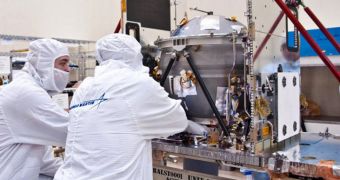As part of its Discovery Program, the American space agency plans to launch a new spacecraft in 2011. Dubbed Gravity Recovery and Interior Laboratory (GRAIL), the mission will include several components, of which one is to take off next year. Just recently, scientists managed to finally confirm the size and fit of a key component in the future spacecraft, and namely the fuel tanks. Thanks to the conclusions of this important assessment, engineers can now proceed to weld the components into the propulsion system's feed lines.
The propulsion subsystem assembly and integration phases of the construction stage are currently underway in Denver, at Lockheed Martin Space System's (LMSS) Space Support Building clean room. The image to the left was taken about a year ago, as engineering teams belonging to the contractor were carrying out assembly work. Once completed, the two spacecraft that make up the GRAIL mission will fly in tandem orbits around the Moon for several months. The goal of the flight will be to measure the natural satellite's gravity field, with an unprecedented level of detail.
There are still numerous questions that planetary scientists ask about the Moon, and many of them have no clear answer. Experts behind GRAIL hope that this approach to obtaining clear-cut conclusions will be successful. “As NASA moves forward with exploration endeavors, our lunar science missions will be the light buoy leading the path for future human activities,” said the director of the NASA Science Mission Directorate Planetary Division, Jim Green.
GRAIL's principal investigator is Maria Zuber of the Massachusetts Institute of Technology (MIT), in Cambridge. Zuber's team of expert scientists and engineers includes former NASA astronaut Sally Ride, who will lead the mission's public outreach efforts. Up to five cameras aboard each spacecraft will allow students and the public to participate in GRAIL’s mission of lunar exploration. Each GRAIL spacecraft will carry the cameras to document their views from lunar orbits.
The twin spacecrafts will support NASA's exploration goals as the agency plans to returns humans to the Moon. In 2008, the agency launched the Lunar Reconnaissance Orbiter (LRO) to circle the Moon for at least a year and take measurements to identify future robotic and human landing sites. The orbiter also looks for potential lunar resources and document aspects of the lunar radiation environment. After a 30-year hiatus, LRO represents NASA's first step toward returning humans to the Moon. GRAIL’s high-resolution gravity measurements will complement LRO’s high-resolution observations of the lunar surface.

 14 DAY TRIAL //
14 DAY TRIAL //